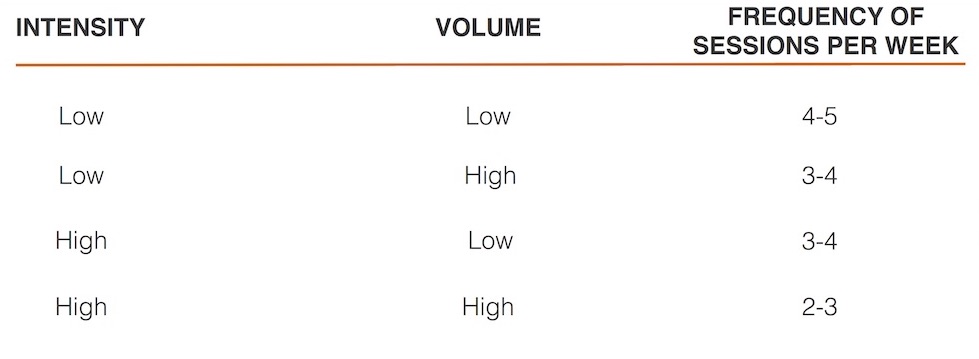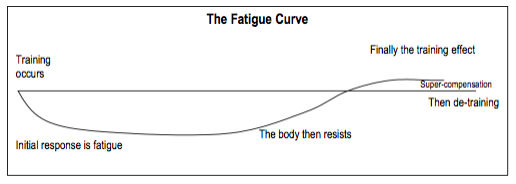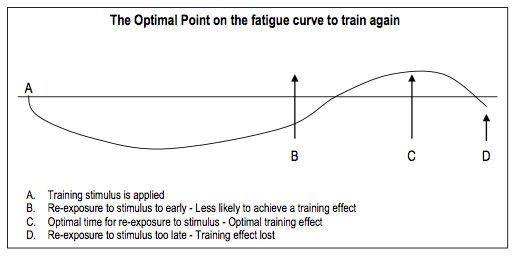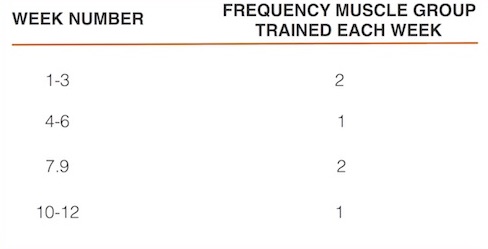Frequency of training refers to the number of training sessions performed over a period of time. This is usually for a period of a week but could also refer to the number of training sessions within one day.
The more typical approach to training frequency has been three workouts per week, performed on Monday, Wednesday, and Friday, were found to allow adequate recovery, especially for the novice. This is one of the more common methods taught in certification courses and text books however this may not be optimal.
The frequency of training is inversely related to both intensity and volume. When either the intensity or volume is increased the frequency of the training must be compensated to account for the necessary increase in recovery.

The clients’ chronological age may influence the frequency. Due to a decrease in hormone levels associated with aging may result in a reduction in the ability to recover from training. These changes in hormonal levels may be first evident either in the late 20’s or early-mid 30’s. Telomere shortening due to aging or other factors can greatly compromise recovery from training thus having a direct impact on training frequency.
Training frequency is related to muscle size and number of motor units involved. Smaller muscle groups may recover more quickly than larger muscle groups; therefore they can be trained more frequently. Dr. Fred Hatfield covers this in detail in his book Bodybuilding: A Scientific Approach (1984) where he discusses the system of Variable Split.
Training frequency is related to the selection of exercises. Multi-joint movement (compound exercises) may reduce frequency requirements of the assistant muscle groups. Also the response of the body to particular exercises will also vary adoption; for example the Deadlift may require greater recovery than the bench press. Exercises that involve a smaller number of motor units such as calves can be performed more frequently. These factors come in to play with the above Variable Split system.
Training frequency is influenced by recovery ability. Optimal training frequency will be highly influenced by the ability of the client recover from the specific training. Employing specific recovery techniques post training and between training sessions can assist this but a sill limited by individual factors discussed.
Individualization frequency guidelines
At best optimal frequency can only ever be an educated calculation base on data gathered. It is very difficult with complete accuracy predict the rate of adaptation of an individual. Monitoring recovery can assist with determining the idea frequency for the individual at a single point in time but because variables are always changing it requires constant monitoring.
An individual’s goal may contribute to determining the frequency of training as long as all other factors are also taken into consideration. Determining goals will allow a realistic estimated training training frequency to attain those goals in the set time frame.
As with other training variables recovery is transient in that what has worked in the past may not necessarily work in the future. However this should provide some guidance to what has worked and were to head as far as frequency. The better monitoring at record keeping the better the data gathered can assist with future programming.
Frequency of training may also be influenced by the individual’s genetic make up. This should not be used as an excuse but rather to an opportunity optimize training frequency for the individual based on the individuals genetic profile. (More on this in the section on Genetics)
Recovery is a complex variable along with fatigue that involves many different parameters and they may not all fatigue or recover at the same rate. The complexity of this is amplified by the client’s individual rate of fatigue and recovery. Current stress factors alone can distract from recovery therefore all factors should be monitored and recorded (discussed in detail under the Rest & Restoration section). There is something to be said for instinctive training where you listen to your body however this should not be abused as it should be qualified with other methods of monitoring recovery.
The best way to determine the appropriate frequency is to determine at what point the client will have not only recovered, but super-compensated.


Periodization of frequency: Strength Training
Frequency should be periodized, but is primarily influenced by the other acute training variables being manipulated through periodization concept.
An example of this could be during a higher volume phase frequency of training may need to be adjusted to account for the recovery factor from doing a higher volume program.
Periodization of frequency: Muscle Group
Again this concept may be influenced by the other acute training variables but can be used in the more advanced client or in latter stages of the periodization plan.
During phases of increased frequency volume may be reduced and intensity increased. Then during phases of decreased frequency, volume may again be increased. Using this model frequency becomes one of the primary variable.

Recovery must be carefully monitored during phases of increased frequency to ensure that the client does not become overtrained.
